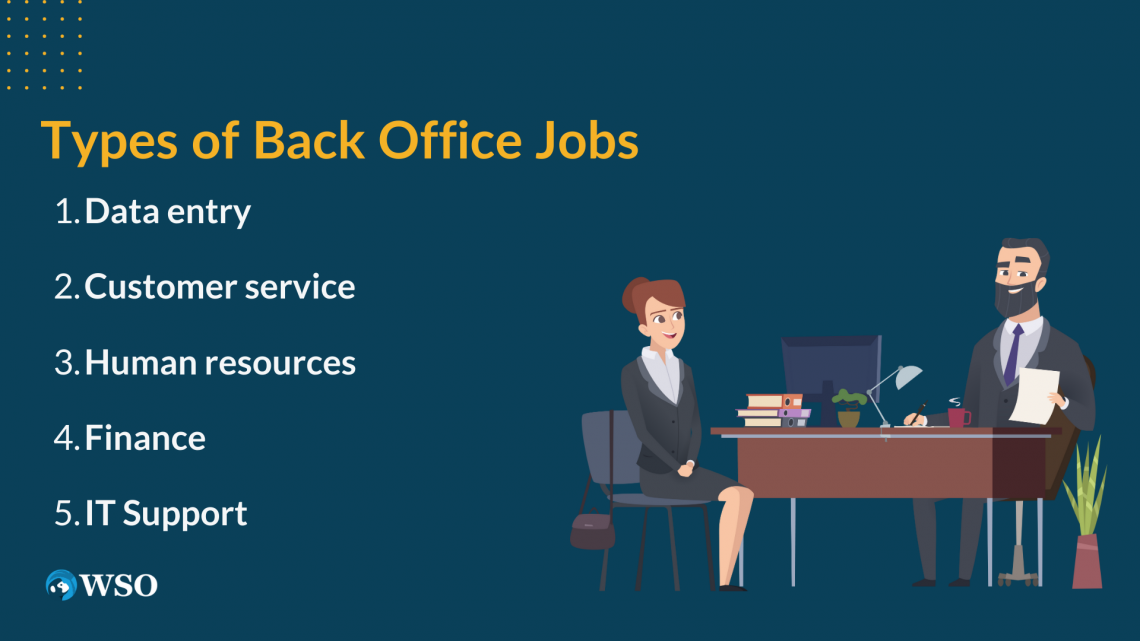Back Office
Part of an organization that handles all internal processes and information management.
The back office is part of an organization that handles all internal processes and information management.

Companies organize their offices to allow the front office to deal with customer interactions. In contrast, the back office deals with processes that do not require client relations. However, these two divisions are still found in many companies that have to physically contact consumers—for example, banks, insurance companies, and car dealerships.
This office is a company segment that involves the process responsible for running a business's daily operations.
In contrast to the front office, which includes all activities related to direct customer contact, the back is responsible for providing infrastructure, administration, and production.
Therefore, a well-structured back office is the cornerstone of a properly equipped customer service staff. If the technical infrastructure in this division does not work well, communication with the customer will not be effective.
Examples of this office roles are the personnel department, the accounting department, IT support, or the switchboard. This office acts in the "background" and maintains the main activity.
This office refers to the administrative or secretarial staff. They usually take care of the organizational flow of internal processes.
Back Office concerning customers
Customer interaction is a criterion that contributes to understanding how the back office functions. It is often said that this division needs more contact with customers.

However, such a formulation reveals a certain vagueness. Since the this office segment deals with internal information, management, and process support, the front-office employees will rely on back-end employees.
The project manager needs an up-to-date project plan, the development manager will need a progress report, and the salesperson will need a written offer to send to their prospects.
Project managers, development managers, and salespeople rely heavily on the back office's support. With it, front-office employees will be able to complete day-to-day tasks.
NOTE
The back office will sometimes be in contact with customers.
Many of you may wonder if its employees have any contact with the end customer. Yes, this is common today.
End customers contact organizations because they have questions about the duration of their contracts, they want to book or terminate services, and something needs to be fixed.
Front Office Vs. Back Office
The front office corresponds to the actions, functions, and tasks related to selling products or services involving direct contact with the customer.
The front office includes sales and other functions in direct contact with customers (such as delivery, customer support, after-sales service, etc.)

Simply put, it is often assumed that front-office employees are the ones on the front line and are the significant guarantors of the company's brand image.
In contrast to the front office, the back office integrates all administrative and logistical sales-related tasks. This can include tax declarations, stock updates, management of payment methods, etc., or even the direction of web or social media platforms.
In short, these functions are not in direct contact with customers and bring together all the company's internal processes, whether the production, accounting, human resources departments, etc.
The terms back or front office are prevalent in the banking sector. In this context, the former includes receptionists, advisors, etc., while the latter refers to technical positions often based at the company's headquarters.
Even though one might think that this is the case, these two divisions are only partially isolated since the teams in charge of customer relationship management must know a minimum of data concerning the process of realization of the company's offering.
Types of back office jobs
A firm's success depends on its back-office positions. These professions frequently differ in knowledge, abilities, and education required. Skills are essential for any back office role and can vary depending on the situation.

The competencies required for a financial manager differ from those required for a human resource manager. While the latter may need to concentrate on learning financial analysis abilities and frequently use computer skills like excel or PowerPoint, the former needs adequate training in interpersonal communication skills and staff coaching.
Although many back-office professions call for a business or an IT degree, the experience must be role specific. Here is a list of the most well-known back office jobs with information about each position's compensation, job satisfaction outlook for the future, and educational requirements.
Data entry
A data entry operator is tasked with manually entering data into a computer system on behalf of a company. The information could relate to clients, goods, finances, personnel, etc.

1. Income
Several variables, including geography, experience level, and company size, affect the typical salary for a data entry operator. Generally, this profession pays between $20,000 and $35,000 annually on average in the US.
2. Job satisfaction
While some people could perceive this work as boring and unchallenging, others view it as a crucial position that helps the business run smoothly.
3. Qualifications
In most cases, a high school diploma and reliable computer software and data entering experience are required to work as a data entry operator. However, some employers could demand more education or professional experience.
4. Future Outlook
The continual requirement for effective data entry and storage can guarantee a steady demand for data entry operators. However, as data entry procedures become more automated, there might be less demand for this profession in the future.
Customer service
A customer service representative assists clients of a business in resolving issues or responding to inquiries. You can do this over the phone, by email, live chat, or in person.

1. Income
Location, experience, and firm size affect a customer support agent's average salary. Generally, this profession pays between $25,000 and $40,000 annually on average in the US.
2. Job satisfaction
Customer service agents' feelings regarding their jobs' pleasure differ. Due to the interaction with challenging clients, some people may find this profession unpleasant and difficult, while others may view it as a fulfilling job that benefits others.
3. Qualifications
In most cases, a high school graduation and strong oral and written communication abilities are required to work as a customer service agent. However, some employers could demand more education or professional experience.
4. Future outlook
As long as businesses strive to offer their clients high-quality service, there will be a steady demand for customer care representatives.
However, using instant messaging, live chat, and other online communication tools may increase due to digital transformation, which may decrease the demand for in-person customer care representatives.
Human resources
A human resources manager is in charge of organizing personnel management-related tasks inside an organization. This can entail recruiting and employing new workers, controlling wages and benefits, settling workplace disputes, and implementing human resources policy.

1. Salary
Location, experience, and firm size affect a human resources manager's average pay. Generally, in the US, this profession pays between $60,000 and $100,000 a year.
2. Job satisfaction
Due to the complexity of the decisions that must be taken, some people might find this job difficult, while others would find it a fulfilling profession that helps the business run smoothly.
3. Qualifications
Candidates for the human resources manager position should possess at least a bachelor's degree in business administration or human resources and substantial relevant work experience.
4. Future outlook:
Since businesses are constantly looking for ways to manage their staff members effectively, the demand for human resource managers is expected to remain consistent. Nevertheless, some human resources professions may become less necessary as more tasks are automated.
Finance
The financial management of a company or organization is within the purview of the finance manager. They oversee accounting, cash management, financial reporting, and budget planning.

1. Salary
According to the bureau of labor statistics, the finance manager role is one of the most promising professions.
With an annual salary of 153,460 USD and a projected growth rate of 17% between 2020 and 2030, this profession is nowhere near extinction.
2. Job satisfaction
The financial manager profession provides a stable career path. Furthermore, having a wide range of employment alternatives across different industries increases flexibility and lowers the chance of losing a job.
3. Qualifications
Must be an expert in numbers, mastering legal and compliance aspects. Cash flow management, budgeting, financial projections, implementing management tools, or controlling financial health and accounting are all missions that remain on the financial manager's credit.
4. Future outlook
To reinvent itself in a new era, the finance function transforms into a data-driven decision center, where people and machines help make better strategic and operational financial decisions.
To have the potential to achieve this role, aspiring CFOs must have a clear development strategy that addresses current needs and future concerns.
IT Support
The IT support manager is a qualified individual tasked with leading and overseeing a group of specialists who offer end users IT assistance.

They often guarantee service quality, ensure technical issues are fixed promptly and effectively and provide users with pertinent information.
1. Salary
Depending on criteria including geography, firm size, experience, and skill set, the average salary for an IT support manager might vary significantly. In the United States, the typical salary for an IT support manager is between $60,000 and $90,000.
2. Job satisfaction
Workplace conditions, the caliber of relationships with coworkers and superiors, and the level of appreciation for one's efforts are just a few of the variables that affect how satisfied an IT support manager is in their position.
However, professionals in this industry might be content with their employment if they enjoy assisting others in resolving technical issues and are happy with their compensation and perks.
3. Qualifications
A degree in computer science, systems management, or a closely related discipline, as well as prior experience in technical assistance or team management, are typically requirements for an IT support manager.
4. Future outlook
With prospects for career advancement, specialization, and acquiring new skills, IT support managers may have a promising future. Given the demand for IT professionals across various businesses, they can also have the chance to work in other fields.
Key Takeaways
- Any business should prioritize its back office. Its efficient operation will help achieve a business' future objectives. In addition, effective management of the department's communication with other divisions is essential for any business.
- While the front office is thought to be the most fun to work in, the back-end staff is considered the foundation of a company, and with their competence, the front office would achieve the desired goals.
- Jobs in the back end could have multiple dimensions. The HR, data entry, finance, customer service, and IT support types are the most common.
- Traditional back-end occupations are in less demand. Thus new positions in the same division are emerging, including software engineering, data analysis, and artificial intelligence.





or Want to Sign up with your social account?